Emanuel Gil-Av and the Separation of Enantiomers on Chiral Stationary Phases by Chromatography
LCGC North America
Guest columnist Volker Schurig discusses the achievements of Emanuel Gil-Av in introducing enantioselectivity into chromatographic analysis.
On the verge of the Third Millennium, the worldwide budget for chiral technology amounted to $150 billion per year, with chiral analysis accounting for 0.1% but still comprising $150 million, a huge sum, and with an annual growth rate of 15%. Various applications of chiral analysis in different research fields are depicted in Figure 1.
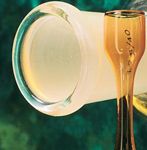
One of the main tools of chiral analysis is based upon enantioselective chromatography. Emanuel Gil-Av's group at The Weizmann Institute of Science in Rehovot, Israel, played a pioneering role in the development of the direct separation of enantiomers by gas chromatography (GC) in the 1960s. Subsequently, their discoveries formed the basis of further developments in liquid chromatography (LC), supercritical fluid chromatography (SFC), and in various electromigration methods. On the 90-year anniversary of Gil-Av's birth and the 10-year anniversary of his death, this installment of "Milestones in Chromatography" pays homage to his pioneering work.

Leslie S. Ettre
The Status of Enantioselective GC Around 1960
There are two possible approaches for separating enantiomers by GC: an indirect and a direct approach. The indirect approach is based upon the formation of diastereomeric derivatives by reaction with an enantiomerically pure chiral auxiliary compound and separation of the former on a convential achiral stationary phase in the spirit of Pasteur's resolution principles (1). This method requires the absence of kinetic resolution and the absence of racemization of both reaction partners during derivatization as well as the unbiased detection of diastereomers. In the direct approach, enantiomers are separated via the noncovalent diastereomeric interaction with a nonracemic chiral stationary phase. The rapid and reversible formation of diastereomeric association complexes of distinct stabilities will bring about differences in the partition coefficients of the enantiomers and, hence, it should result in chromatographic resolution. As recalled by Gil-Av (Figure 2) (2):
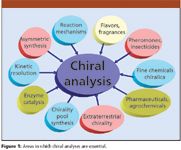
Figure 1
We focused our attention on the second alternative, where the handedness needed for resolution is provided by an optically active environment in the phase, and not introduced covalently into the molecules to be separated. When we started this work in 1964, this topic was in a "state of frustration." Nobody believed that it could be done. In fact, people were convinced that there could not possibly be a large enough difference in the interaction between D- and L-solute with an asymmetric solvent. This was the feeling people had, even those known as unorthodox thinkers. This view had also some experimental basis, because a number of communications has been published, in which it was claimed that such resolutions could be effected, but nobody was able to reproduce these results, and some of them were shown to be definitely wrong.
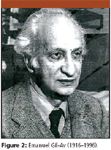
Figure 2
When we started our work with B. Feibush – who had the courage to accept this problem for his Ph.D. thesis (3) — we based ourselves on the following two ideas. First of all, nature can do it, enzymes differentiate between enantiomers. Therefore we thought: let us have a system, which has some of the properties, at least in a rudimentary fashion, of an enzyme. In other words, we decided to try phases with –CO- and –NH-functions grouped around an asymmetric center, capable of forming hydrogen bonds with suitable solutes, i.e. derivatives of α-amino acids. Secondly, we reasoned that we had to amplify the effect, because we expected it to be very small. This meant the use of long capillaries. As stainless steel is expensive, and we expected the need for many columns we decided to start by building a (glass) capillary drawing machine, and by acquiring the delicate skills of drawing long capillaries and coating them. After a period of frustration — a period lasting about one year — the idea worked.
The Discovery of the First Separation of Enantiomers on a Chiral Stationary Phase by GC
In 1966, Gil-Av, Feibush, and Charles-Sigler utilized an experimental setup that was not much different than that used today (4). The experiments were carried out with a Perkin-Elmer Model 801 chromatograph adapted for capillary columns and provided with a split injector (heated to 90 °C) and a flame ionization detector (operated at 210 °C). Nitrogen was used as the carrier gas, at 20 psig inlet pressure. The samples were diluted in diethyl ether and injected with a split ratio of 100:1. Vitreous capillary columns (50–100 m × 0.25 mm) were drawn from Pyrex glass tubing according to the procedure of Desty and colleagues (5). A homemade apparatus was used that was built upon the valuable advice of G.P. Cartoni of the University of Rome, Italy. Such glass-drawing machines also were available commercially and were used widely, even after the advent of fused-silica capillary tubing.
After cleaning with different solvents, the column was coated with a 20% solution of the chiral stationary phase N-trifluoroacetyl-L-isoleucine lauryl ester in diethyl ether by the plug method. After conditioning overnight at 80 °C, the column exhibited 140,000 theoretical plates for 2-heptyl acetate, permitting the partial resolution of the volatile trifluoroacetyl alkyl esters of natural α-amino acids, specially the 2-propanol, n-butanol and cyclopentanol esters of N-trifluoroacetyl-alanine. More intriguingly, the diastereomeric N-trifluoroacetyl-α-amino acid esters of chiral 2-butanol, which were studied previously by the indirect method, gave rise to four peaks on the chiral stationary phase, corresponding to two enantiomeric pairs DD/LL (like) and DL/LD (unlike), whereas only the two peaks of the like and unlike diastereomers were observed on an achiral phase. The first simultaneous separation of various enantiomeric pairs obtained in 1965–1966 on a chiral stationary phase by GC is shown in Figure 3. As stated by Gil-Av (2):
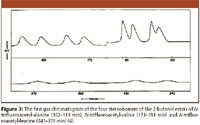
Figure 3
We were very skeptical when we saw the first set of four peaks (alanine), became hopeful when the second set of peaks appeared (valine), and were convinced that we had solved the problem when the leucine peaks emerged one after the other after six hours of tense waiting.
To prove that enantiomers were indeed separated, two decisive control experiments were carried out by Gil-Av, Feibush, and Charles-Sigler (4). Mixtures of D- and L-amino acid derivatives in varying ratios were prepared and after injection onto the enantioselective column, it was found that the peak areas corresponded well to the proportions of the enantiomeric mixture investigated. Then the configuration of the chiral stationary phase was reversed from L- to D-isoleucine leading to a peak reversal of the samples enriched in one enantiomer. This experiment unequivocally and conclusively proved that incongruent mirror-image isomers had been separated for the first time by GC. Quoting from the paper of Gil-Av, Feibush, and Charles-Sigler (4):
The achievement of resolution of optical isomers is one of the most striking demonstrations of the efficiency of gas–liquid partition chromatography. The columns described should have interesting analytical applications and also might serve as a tool for the study of stereospecific interactions.
Indeed, Gil-Av and his coworkers subsequently studied the structural features influencing resolution, hoping that the results would permit extrapolation to other solute–solvent systems and, thus, help to find suitable chiral stationary phases for other classes of racemic compounds.
The importance of the work was indicated in a brief note in the news section of the major German journal Angewandte Chemie (6). Soon Gil-Av presented a major report on their work entitled "Separation of Enantiomers by Gas–Liquid Chromatography with an Optically Active Stationary Phase" at the Sixth International Symposium on Gas Chromatography held in September 1966, in Rome, Italy (7). In this paper, he demonstrated the resolution of eighteen pairs of enantiomers of N-trifluoroacetyl-α-amino acid esters using N-trifluoroacetyl-D- or L-isoleucine lauryl ester, and N-trifluoroacetyl-L-phenylalanine cyclohexyl ester as the stationary phases (7). In all instances, it was found that the derivatives of L-amino acids were eluted after the corresponding D-enantiomers on columns coated with a stationary phase having the L-configuration, and vice versa for the D-phase.
The participants of the symposium immediately recognized the importance of Gil-Av's presentation. This is best shown by the remark of B.L. Karger of Northeastern University, Boston, Massachusetts, during the discussion session: "I would like to congratulate Dr. Gil-Av on succeeding in a problem that several workers have tried over the years. I have no doubt that this work will have great analytical implications." In the ongoing discussion, it was clarified that the second chiral center in the isoleucine stationary phase did not contribute to chiral discrimination. Gil-Av also mentioned that the difference in the free energies of solvation Δ(ΔG) of the diastereomeric associates leading to resolution amounted to only 6–30 cal/mol at the temperature of measurement. The separation was thought to be due to hydrogen-bonding between NH
•
•
•F and NH
•
•
•O=C- functions, whereby the latter contribution was considered to be more important.
While up until then, all separations were performed on an analytical scale, another pioneering paper was published soon afterwards (8), representing the first approach for the semipreparative separation of enantiomers by GC, now using an enantioselective packed column. Moreover, a chiroptical method was employed to identify the separated enantiomers unequivocally. As a new, versatile chiral stationary phase, a dipeptide derivative was employed for these separations. The three chromatograms in Figure 4 compare the performance of such a column with one containing an achiral (non-enantioselective) phase. On the latter, the D and L isomers are not separated (Figure 4a). However, when the fraction corresponding to the racemic compound was rechromatographed on a column coated with a chiral phase (Figure 4b), partial separation was achieved. Figure 4c shows the optical rotatory dispersion (ORD) diagram of the two collected fractions corresponding to the hatched areas in Figure 4b, indicating opposite rotation angles (8).

Figure 4
Extending the Scope of the Direct Separation of Amino Acid Derivatives on Chiral Stationary Phases by GC
The further development of the direct separation of enantiomers by GC has been reviewed thoroughly in the literature (2,9). By way of ingenious experiments, optimum chiral stationary phase performance was accomplished. As expected, peak reversal was observed with the derivatized mirror image dipeptide phases L-Val-L-Val and D-Val-D-Val. On the diastereomeric dipeptide phase L-Val-L-Val, as compared to D-Val-L-Val or L-Val-D-Val, peak reversal only occurred on changing the configuration of the N-terminal amino acid. This also was confirmed by the finding that Gly-L-Val possessed significantly inferior enantioseparating properties to L-Val-Gly. Consequently, the C-terminal amino acid in the dipeptide phase was considered not to contribute to enantioselectivity but only to provide the second amide bond required for hydrogen-bonding. The C-terminal amino acid was therefore substituted by a tert-butyl group to yield the versatile monoamino acid diamide selector N-lauroyl-L-valine-tert-butyl-amide (10) (Figure 5).
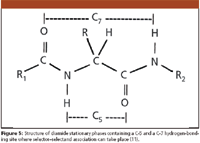
Figure 5
The work of Gil-Av aroused the interest of the Manned Spacecraft Center of NASA and he was invited to Texas to determine organogenic elements and compounds in lunar samples retrieved by the crew of Apollo 11 from the surface of the Sea of Tranquility in an effort to detect chiral amino acids in extraterrestrial space. The results turned out to be negative, at least at the nanogram detectability range. In the laboratory of Albert Zlatkis at the University of Houston, Gil-Av met Ernst Bayer from Tübingen University, Germany, who at that time held a Robert A. Welch professorship in Houston. As Bayer also was an established peptide chemist embarking on Merrifield synthetic approaches, he supplied di- and tripeptides to Gil-Av in an ensuing cooperation. Coworkers of Bayer from Tübingen — Günther Jung, Wolfgang Parr, and Wilfried A. König — conducted experiments in Houston (2,9). König was later connected with important work in the area of chiral separation at Hamburg University, Germany.
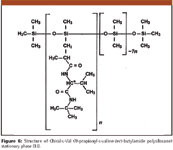
Figure 6
A breakthrough of enantioselective GC was achieved in 1977 when E. Bayer, now back at Tübingen University, with H. Frank and G.J. Nicholson, linked the valine diamide selector of Feibush to a polysiloxane, thereby combining enantioselectivity with the advantageous GC properties of polysiloxanes (12). The chiral polysiloxane containing valine diamide (see Figure 6) was termed Chirasil-Val (13), and was commercialized as the enantiomeric L- and D-form allowing for peak switching scenarios in chiral analysis. The simultaneous enantiomeric separation of the 17 α-amino acids as N-trifluoroacetyl alkyl esters on Chirasil-Val shown in Figure 7 might be regarded as true art in science. Compared to the rather archaic type of peaks in the first trials of Gil-Av, this high-resolution enantiomeric separation is truly remarkable.
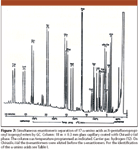
Figure 7
Further Approaches to the Separation of Enantiomers by GC Initiated by Gil-Av
Within the framework of cooperation between Gil-Av and Bayer at Houston, the present author was invited to join The Weizmann Institute of Science in 1969 to work on the new and exciting topic of the separation of enantiomers by GC (Figure 8).
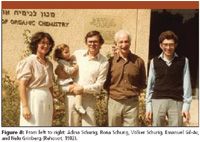
Figure 8
Because my background was metal-organic chemistry — my doctorate thesis at Tübingen University (1968) was concerned with inorganic nitrogen fixation and reduction to ammonia — the challenging task of separating enantiomers on optically active metal coordination compounds by GC was tackled (14). Gil-Av and Joseph Shabtai had earlier extensively investigated the separation of olefins and aromatics in oil shale deposits of the Dead Sea area as a possible source of liquid fuel. They used packed GC columns coated with silver nitrate in ethylene glycol for the selective separations of isomeric olefins including cis–trans geometric isomers. Thus, we decided to attempt the separation of chiral olefins by complexation GC, invoking enantio-selective interaction via coordination. Palladium(II) and platinum(II) complexes containing optically active phosphite ligands were prepared and used as chiral stationary phases in packed columns. These efforts coincided with the development of chiral rhodium(I) phosphane catalysts for asymmetric hydrogenation of prochiral olefins at this time. However, the enantioselective approach totally failed in GC.

Figure 9
Meanwhile, Feibush (Figure 9) — a former graduate student of Gil-Av — worked between 1967 and 1969 as a postdoctoral fellow at the Aerospace Research Laboratories at Wright-Patterson Air Force Base, Ohio, with C.S. Springer and R.E. Sievers. They prepared volatile metal chelates for the analysis of lanthanides by GC and investigated the stereoisomers of cobalt(III) tris(3-acetyl-1R-camphorate) followed by a comprehensive GC study of the interaction of weak donor ligands with lanthanide 3-acyl-1R-camphorate chelates. Finally, a breakthrough was achieved when Feibush suggested the use of optically active 3-trifluoroacetyl-1R-camphor as the ligand for rhodium(I). But it took six years until we could demonstrate the first enantiomeric separation of the racemic olefin 3-methylcyclopentene on dicarbonyl-rhodium(I)-trifluoroacetyl-1R-camphorate (15), although the feasibility of such separations had been predicted previously by Schurig, Zlatkis, and Gil-Av (16). The successful separation of enantiomers by complexation GC was proved by reversal of the peak elution order of the olefin enriched in the R-enantiomer on the mirror-image rhodium complexes (Figure 10).
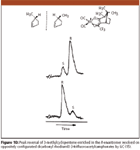
Figure 10
Enantioselective complexation GC later was extended to other optically active transition metal chelates and Chirasil-Metal chiral stationary phases were developed for various applications (14). Lanthanide tris(3-acyl-1R-camphorates) also became important chiral paramagnetic shift reagents for enantioselective nuclear magnetic resonance (NMR) spectroscopy.
Chiral molecules such as halocarbons and saturated hydrocarbons, devoid of functions prone to strong hydrogen-bonding and metal coordination, resisted enantioseparation by Chirasil-Val- and Chirasil-Metal-type chiral stationary phases. Therefore, Gil-Av suggested trying cyclodextrins as inclusion-type chiral phases in GC, a topic already well developed in Czechoslovakia by Eva Smolková-Keulemansova for achiral separations. Young Hwan Kim came in 1981 from Rehovot to Tübingen as a postdoctoral fellow to conduct some initial trials using permethylated β-cyclodextrin dissolved in polysiloxane and coated on stainless steel capillaries for the resolution of a chiral hydrocarbon (2,2,3-trimethylheptane). Unfortunately, the attempt failed at that time, although the system then used by us now represents the most versatile selector system for the separation of enantiomers by GC. Even the original goal to enantioseparate chiral unfunctionalized saturated hydrocarbons has been solved on Chirasil-Dex (14).
The Impact of Gil-Av's Work to Enantioselective LC and Electromigration Methods
Before Gil-Av's activities, the optical enrichment of Tröger's base on D-lactose using LC by Prelog and Wieland (17) was acknowledged by the scientific community but generally, it was thought that such processes would be inefficient and limited in scope. Then, in the 1970s, Gil-Av extended his investigations to enantioseparation by high performance liquid chromatography (HPLC). The first part of these investigations represented part of the work of his graduate student František Mikeš and was summarized in 1975 in his doctorate thesis on resolution of chiral compounds by HPLC (18). The first important separation shown and published separately was that of inherent chiral helicenes via charge-transfer complexing agents (19).

Table I: Identification of the a-amino acid enantiomer pairs in the gas chromatogram of Figure 7 obtained on a capillary column coated with Chirasil-L-Val*
In his thesis, Mikeš also introduced the now widely accepted terms selector (solvent) and selectand (solute) for enantioselective chromatography, in analogy to operator–operand, the terms of Ashby, and he also proposed the possibility of reversing the functions of selectors–selectands, that is, using the helicenes as the resolving agents ("reciprocal principle") (18).
In 1966 at the University of Illinois, Urbana, W.H. Pirkle developed chiral solvating agents for enantioselective NMR spectroscopy, and by the end of the 1970s, he extended the observed chiral recognition phenomena, including the "reciprocal principle" to LC (20). (For a discussion of Pirkle's results, see the review of Welch [21]). It also should be mentioned that in Moscow, Rogozhin and Davankov demonstrated the use of polymer-bound L-proline as chiral selector for the LC separation of racemic DL-proline in the presence of copper(II) ions (22). Hare and Gil-Av have later shown that the copper(II)-chelate selector can be added directly to the mobile phase (23). Today, the strategy of using chiral mobile phase additives for enantiomeric separations first conceived by Pirkle (20) represents a standard strategy in enantioselective electromigration methods. In Gil-Av's laboratory, the method of ligand-exchange chromatography also was extended to thin layer chromatography by Shulamit Weinstein: reversed-phase plates, pretreated with the copper(II) chelate of N,N-di-n-propyl-L-alanine, permitted the enantioselective separation of all dansylated proteinogenic α-amino acids except proline (24).
Further landmarks of Gil-Av's research are the discovery of a temperature-dependent reversal of enantioselectivity via enthalpy–entropy compensation (25), which also was found in complexation GC (26), and the existence of nonlinear effects leading to enantiomer enrichment during chromatography on achiral stationary phases (27,28).
A Tribute
In the 1960s, when Gil-Av started his fundamental research on the direct GC separation of enantiomers, the area was in a state of frustration. Now, 40 years later with the availability of various Chirasil-type chiral stationary phases and modified cyclodextrins, the situation is totally reversed and one hardly could find any class of chiral compounds that would resist enantioseparation by high-resolution chromatography. This is principally the merit of his pioneering investigations.
Life
This discussion would not be complete without a brief summary of Gil-Av's life.
Gil-Av was born in 1916 in the small town of Penza in Tsarist Russia, just before the Bolshevik Revolution. His original family name was Zimkin. His father, a physician, died early and his mother, with her two children, left Russia joining her family in central Europe, and then in 1928, the whole clan emigrated to the Holy Land. After attending high school at Tel-Aviv, Gil-Av studied petroleum chemistry at the University of Strasbourg, France. Shortly before the German invasion of France, in 1940, he was able to escape from France, finding both refuge and a job in England. He eventually found his way to Chaim Weizmann's chemical laboratory in London and later to Petrochemical Ltd. in Manchester.
In 1946, Gil-Av returned to Palestine, and joined The Daniel Sieff Institute in Rehovot. This institute was founded in 1934 and in 1949, was renamed The Weizmann Institute of Science. He earned the Ph.D. degree under the supervision of Dr. E.D. Bergmann in 1951. At that time, he changed his family name to Gil-Av. In the 1950s, he studied the possibility of using oil-shale deposits of the Dead Sea area as a source of liquid fuel. This led him to become familiar with mass spectrometry and gas–liquid chromatography employing complex-forming stationary phases. These studies were extended in identifying carcinogenic polycyclic aromatic hydrocarbons (PAHs) in tobacco smoke. The existence of a center of peptide chemistry at The Weizmann Institute together with Gil-Av's outstanding successes in GC separation methods, brought him to the study of chiral molecules such as α-amino acids, applying chromatographic methodology for chiral discrimination, the subject of our report.
At the Seventh International Symposium on Chiral Discrimination (Jerusalem, 1995), Gil-Av, while already very ill, delivered his last lucid lecture on his significant accomplishments in stereochemistry and separation science. With his death on March 24, 1996, the scientific community lost a devoted teacher, a renowned scientist and, a friendly and modest man with a fine sense of humor (29–31).
The Gold Chirality Medal was bestowed upon Gil-Av during the Second International Symposium on Chiral Discrimination in Rome in 1991 for his invaluable contributions to enantioselective chromatography. After his death, a Symposium on Chirality was held on March 31, 1997, at The Weizmann Institute in Rehovot, with speakers from around the world, honoring his achievements. An Emanuel Gil-Av Honorary Issue of the journal Chirality (No. 5 of 1998) also was edited by Nelu Grinberg, one of his former research students.
Leslie S. Ettre From 1988 to 2004, "Milestones in Chromatography" editor Leslie S. Ettre was associated with the Chemical Engineering Department of Yale University (New Haven, Connecticut), first as an adjunct professor and then as a research fellow. Previously, he had been with the Perkin-Elmer Corporation for 30 years. He is currently a member of LCGC's editorial advisory board. Direct correspondence about this column to "Milestones in Chromatography," LCGC, Woodbridge Corporate Plaza, 485 Route 1 South, Building F, First Floor, Iselin, NJ 08830, e-mail lcgcedit@lcgcmag.com.
References
(1) E. Gil-Av and D. Nurok, in Advances in Chromatography, G.C. Giddings and R.A. Heller, Eds. (M. Dekker, New York, 1974), Vol. 10, pp. 99–172.
(2) E. Gil-Av, J. Mol. Evol. 6, 131–144 (1975).
(3) B. Feibush, "Separation of Optical Antipodes by the Method of Gas Chromatography," Ph.D. thesis, The Weizmann Institute of Science, Rehovot, 1967.
(4) E. Gil-Av, B. Feibush, and R. Charles-Sigler, Tetrahedron Letters, 1009–1015 (1966).
(5) D.H. Desty, J.N. Haresnape, and B.H.F. Whyman, Anal. Chem. 32, 302–304 (1960).
(6) Anon., Angew. Chem. 78, 685 (1966).
(7) E. Gil-Av, B. Feibush, and R. Charles-Sigler, in Gas Chromatography 1996 (Rome Symposium) , A.B. Littlewood, Ed. (The Institute of Petroleum, London, 1967); pp. 227–239, discussion: pp. 254–257.
(8) E. Gil-Av and B. Feibush, Tetrahedron Letters, 3345–3347 (1967).
(9) V. Schurig, Angew. Chem., Int. Ed. Engl. 23, 747–765 (1984).
(10) B. Feibush, Chem. Commun. 544–555 (1971).
(11) B. Feibush, Chirality 10, 382–395 (1998).
(12) H. Frank, G. J. Nicholson, and E. Bayer, J. Chromatogr. Sci. 15, 174–176 (1977).
(13) G.J. Nicholson, H. Frank, and E. Bayer, J. High Resolut. Chromatogr. 2, 411–415 (1979).
(14) V. Schurig, in A Century of Separation Science, H.J. Isaaq, Ed. (Marcel Dekker, New York, 2001), Chapter 21, pp. 327–347.
(15) V. Schurig and E. Gil-Av, Israel J. Chem. 15, 96–98 (1976/77).
(16) V. Schurig, R.C. Chang, A. Zlatkis, E. Gil-Av, and F. Mikeš, Chromatographia 6, 223–225 (1973).
(17) V. Prelog and P. Wieland, Helv. Chim. Acta 27, 1127–1134 (1944).
(18) F. Mikeš, "The Resolution of Chiral Compounds by Modern Liquid Chromatography," Ph.D. thesis, The Weizmann Institute of Science, Rehovot, 1975.
(19) F. Mikeš, G. Boshart and E. Gil-Av, Chem. Commun. 1976, 99–100.
(20) W.H. Pirkle, D.W. House, and J.M. Finn, J. Chromatogr. 192, 143–158 (1980).
(21) C. Welch, J. Chromatogr. A 666, 3–26 (1994).
(22) S. V. Rogozhin and V.A. Davankov, Chem. Commun. 1971, 490.
(23) P.E. Hare and E. Gil-Av, Science 204, 1226–1228 (1979).
(24) S. Weinstein, Tetrahedr. Lett., 985–986 (1984).
(25) K. Watabe, R. Charles, and E. Gil-Av, Angew. Chem. Int. Ed. Engl. 28, 192–194 (1989).
(26) V. Schurig, J. Ossig, and R. Link, Angew. Chem. Int. Ed. Engl. 28, 195–196 (1989).
(27) R. Charles and E. Gil-Av, J. Chromatogr. A 605,161–166 (1984).
(28) E. Gil-Av and V. Schurig, J. Chromatogr. A 666, 519–525 (1994).
(29) S. Sarel and S. Weinstein, Enantiomer 1 (4–6), R3–R8 (1996).
(30) V. Schurig, J. High Resolut. Chromatogr. 19, 462–463 (1996).
(31) N. Grinberg, Chirality 10, 373–374 (1998).
Volker Schurig received the Ph.D. degree in 1968 from the University of Tübingen (Germany). After postdoctoral work at the Weizmann Institute of Science (Rehovot, Israel) with Professor E. Gil-Av and at the University of Houston, Texas, with Professor A. Zlatkis he returned in 1972 to his alma mater in Tübingen, and had been associated with the university ever since. He is currently a Professor of Organic Chemistry and Separation Methods. He was the founding editor of the international Journal Enantiomer and presently is a co-editor of the Journal of Chromatography A. Professor Schurig received numerous awards for his pioneering work in the use of chromatography for enantiomeric analysis, among them the M.J.E. Golay Award in Capillary Chromatography and the Chirality Medal (both in 2004).
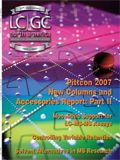
Common Challenges in Nitrosamine Analysis: An LCGC International Peer Exchange
April 15th 2025A recent roundtable discussion featuring Aloka Srinivasan of Raaha, Mayank Bhanti of the United States Pharmacopeia (USP), and Amber Burch of Purisys discussed the challenges surrounding nitrosamine analysis in pharmaceuticals.
Extracting Estrogenic Hormones Using Rotating Disk and Modified Clays
April 14th 2025University of Caldas and University of Chile researchers extracted estrogenic hormones from wastewater samples using rotating disk sorption extraction. After extraction, the concentrated analytes were measured using liquid chromatography coupled with photodiode array detection (HPLC-PDA).













